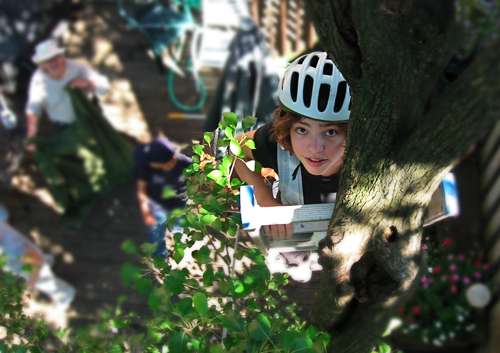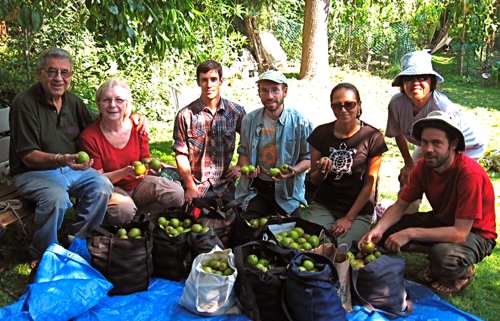 In September, I joined a really cool Toronto group called Not Far From the Tree. They harvest fresh fruit from people’s backyards. The group is made up of volunteer gleaners. Everyone benefits: the tree owners who get a share of the harvest and their yard cleared of falling fruit, the volunteers who get exercise, social interaction and a share of the bounty, and homeless shelters who are the main recipients of this free harvest. The program is also very good for the environment as it supports locally-grown produce – you can’t get more local than a backyard tree. Eating this way avoids agricultural pesticides and herbicides as well as the fuel for long distance shipping.
In September, I joined a really cool Toronto group called Not Far From the Tree. They harvest fresh fruit from people’s backyards. The group is made up of volunteer gleaners. Everyone benefits: the tree owners who get a share of the harvest and their yard cleared of falling fruit, the volunteers who get exercise, social interaction and a share of the bounty, and homeless shelters who are the main recipients of this free harvest. The program is also very good for the environment as it supports locally-grown produce – you can’t get more local than a backyard tree. Eating this way avoids agricultural pesticides and herbicides as well as the fuel for long distance shipping.
John (who lives at the house) and I went on a couple of pear picks this Fall. We were assigned to a huge tree with an enormous bounty of fruit. At the end, our share amounted to over 50 pears each. I climbed high into the tree and took the following photos.

John picking pears with Shannon and Jen, two other volunteers

Helen bravely climbs up to get another heavy bag of pears that I am about to hand her.
A couple weeks later, we picked another pear tree. This time I recorded the count: 12 large bags (and one bucket for the owners). Together they weighed about 250 pounds (over 110 kilograms). I estimate we got 1150 pears from that single tree. There were still a lot more that we couldn’t reach and others that weren’t ripe enough yet. And before we arrived much fruit had already fallen. The owner reported that a small branch weighted with pears had come crashing down a few days prior.

Our team of gleaners including the tree owners on the left. I am in the center. We picked this pear bounty in just a few hours with the help of the blue tarp in the photo. With a person holding each corner, it was held suspended below the tree while I was high up in the canopy shaking branches.
Fruit trees produce a lot food using very little land. Years ago, I researched how much land it takes to feed people. I wanted to know how the land footprint compared between vegetarians and meat-eaters. If you divide all the agricultural land in North America by the population it comes out to about 3.5 acres per person. But it turns out that vegetarians can subsist on a fraction of this amount.
Picking pears this Fall really proved to me how true and important this is. Just a few trees can produce more food than you could possibly eat in a year. Other plant foods such as potatoes and grains are also very productive. Eating low on the food chain frees up farmland that can be returned to wilderness. It also means less soil erosion, less dams, less pesticides and less energy use.
In addition to pears, Not Far From the Tree has picked apricots, apples, elderberries and grapes. So far this year they have picked over 3,003 pounds of fruit that would have otherwise fallen to the ground.





 When giving away old couches, bedding or carpets, leave a note explaining if the home was free from smoking, bed bugs, cockroaches, cats or dogs. Recently
When giving away old couches, bedding or carpets, leave a note explaining if the home was free from smoking, bed bugs, cockroaches, cats or dogs. Recently